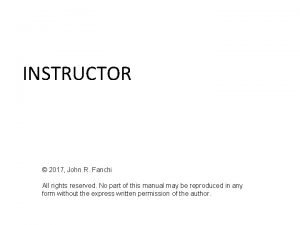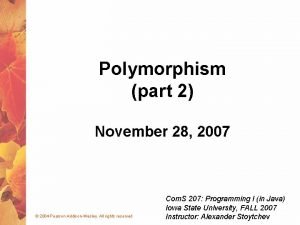Fundamentals Copyright Cengage Learning All rights reserved 1


































- Slides: 34

Fundamentals Copyright © Cengage Learning. All rights reserved.

1. 4 Rational Expressions Copyright © Cengage Learning. All rights reserved.

Objectives ► The Domain of an Algebraic Expression ► Simplifying Rational Expressions ► Multiplying and Dividing Rational Expressions ► Adding and Subtracting Rational Expressions ► Compound Fractions 3

Objectives ► Rationalizing the Denominator or the Numerator ► Avoiding Common Errors 4

Rational Expressions A quotient of two algebraic expressions is called a fractional expression. Here are some examples: A rational expression is a fractional expression where both the numerator and denominator are polynomials. For example, the following are rational expressions: 5

The Domain of an Algebraic Expression 6

The Domain of an Algebraic Expression In general, an algebraic expression may not be defined for all values of the variable. The domain of an algebraic expression is the set of real numbers that the variable is permitted to have. The table in the margin gives some basic expressions and their domains. 7

Example 1 – Finding the Domain of an Expression Find the domains of the following expressions. (a) 2 x 2 + 3 x – 1 (b) (c) 8

Example 1 – Solution (a) This polynomial is defined for every x. Thus, the domain is the set of real numbers. (b) We first factor the denominator. Since the denominator is zero when x = 2 or 3, the expression is not defined for these numbers. The domain is {x | x 2 and x 3}. 9

Example 1 – Solution cont’d (c) For the numerator to be defined, we must have x 0. Also, we cannot divide by zero, so x 5. Thus, the domain is {x | x 0 and x 5}. 10

Simplifying Rational Expressions 11

Simplifying Rational Expressions To simplify rational expressions, we factor both numerator and denominator and use the following property of fractions: This allows us to cancel common factors from the numerator and denominator. 12

Example 2 – Simplifying Rational Expressions by Cancellation Simplify: Solution: Factor Cancel common factors 13

Multiplying and Dividing Rational Expressions 14

Multiplying and Dividing Rational Expressions To multiply rational expressions, we use the following property of fractions: This says that to multiply two fractions we multiply their numerators and multiply their denominators. 15

Example 3 – Multiplying Rational Expressions Perform the indicated multiplication and simplify: Solution: We first factor. Factor Property of fractions Cancel common factors 16

Multiplying and Dividing Rational Expressions To divide rational expressions, we use the following property of fractions: 17

Example 4 – Dividing Rational Expressions Perform the indicated division and simplify: Solution: Invert and multiply Factor Cancel common factors 18

Adding and Subtracting Rational Expressions 19

Adding and Subtracting Rational Expressions To add or subtract rational expressions, we first find a common denominator and then use the following property of fractions: Although any common denominator will work, it is best to use the least common denominator (LCD). The LCD is found by factoring each denominator and taking the product of the distinct factors, using the highest power that appears in any of the factors. 20

Example 5 – Adding and Subtracting Rational Expressions Perform the indicated operations and simplify: (a) (b) Solution: (a) Here the LCD is simply the product (x – 1)(x + 2). Write fractions using LCD Add fractions Combine terms in numerator 21

Example 5 – Solution cont’d (b) The LCD of x 2 – 1 = (x – 1)(x + 1) and (x + 1)2 is (x – 1)(x + 1)2. Factor Combine fractions using LCD Distributive Property Combine terms in numerator 22

Compound Fractions 23

Compound Fractions A compound fraction is a fraction in which the numerator, the denominator, or both, are themselves fractional expressions. 24

Example 6 – Simplifying a Compound Fraction Simplify: Solution 1: We combine the terms in the numerator into a single fraction. We do the same in the denominator. Then we invert and multiply. 25

Example 6 – Solution cont’d Solution 2: We find the LCD of all the fractions in the expression, then multiply numerator and denominator by it. In this example the LCD of all the fractions is xy. 26

Example 6 – Solution cont’d Thus Multiply numerator and denominator by xy Simplify Factor 27

Rationalizing the Denominator or the Numerator 28

Rationalizing the Denominator or the Numerator If a fraction has a denominator of the form A + B , we may rationalize the denominator by multiplying numerator and denominator by the conjugate radical A – B. This works because, by Special Product Formula 1 the product of the denominator and its conjugate radical does not contain a radical: (A + B )(A – B ) = A 2 – B 2 C 29

Example 9 – Rationalizing the Denominator Rationalize the denominator: Solution: We multiply both the numerator and the denominator by the conjugate radical of 1 + , which is 1 –. Multiply numerator and denominator by the conjugate radical Special Product Formula 1 30

Example 9 – Solution cont’d 31

Avoiding Common Errors 32

Avoiding Common Errors The following table states several properties of multiplication and illustrates the error in applying them to addition. 33

Homework Pg 41 2 -4, 7, 11, 14, 24, 31, 36, 40 -60 mult 5, 62, 83, 87, 103, 105 34
 Copyright 2015 all rights reserved
Copyright 2015 all rights reserved Copyright 2015 all rights reserved
Copyright 2015 all rights reserved Dell all rights reserved copyright 2009
Dell all rights reserved copyright 2009 Copyright © 2018 all rights reserved
Copyright © 2018 all rights reserved Copyright cengage learning. powered by cognero
Copyright cengage learning. powered by cognero Specification by example
Specification by example All rights reserved sentence
All rights reserved sentence Creative commons vs all rights reserved
Creative commons vs all rights reserved Confidential all rights reserved
Confidential all rights reserved Sentinel controlled repetition
Sentinel controlled repetition 2012 pearson education inc
2012 pearson education inc Microsoft corporation. all rights reserved.
Microsoft corporation. all rights reserved. Microsoft corporation. all rights reserved.
Microsoft corporation. all rights reserved. Microsoft corporation. all rights reserved.
Microsoft corporation. all rights reserved. Pearson education inc. all rights reserved
Pearson education inc. all rights reserved Warning all rights reserved
Warning all rights reserved Siprop
Siprop Quadratic equation cengage
Quadratic equation cengage Warning all rights reserved
Warning all rights reserved Confidential all rights reserved
Confidential all rights reserved Microsoft corporation. all rights reserved
Microsoft corporation. all rights reserved 2010 pearson education inc
2010 pearson education inc Gssllc
Gssllc Copyright 2010 pearson education inc
Copyright 2010 pearson education inc 2010 pearson education inc
2010 pearson education inc Confidential all rights reserved
Confidential all rights reserved Airbus deutschland gmbh
Airbus deutschland gmbh R rights reserved
R rights reserved Rights reserved
Rights reserved Chapter 6:2 interpreting word parts
Chapter 6:2 interpreting word parts Chapter 5 the cardiovascular system labeling exercises
Chapter 5 the cardiovascular system labeling exercises Cengage learning heart diagram
Cengage learning heart diagram South-western cengage learning
South-western cengage learning Chapter 13 medical math
Chapter 13 medical math 2009 delmar cengage learning
2009 delmar cengage learning


























































